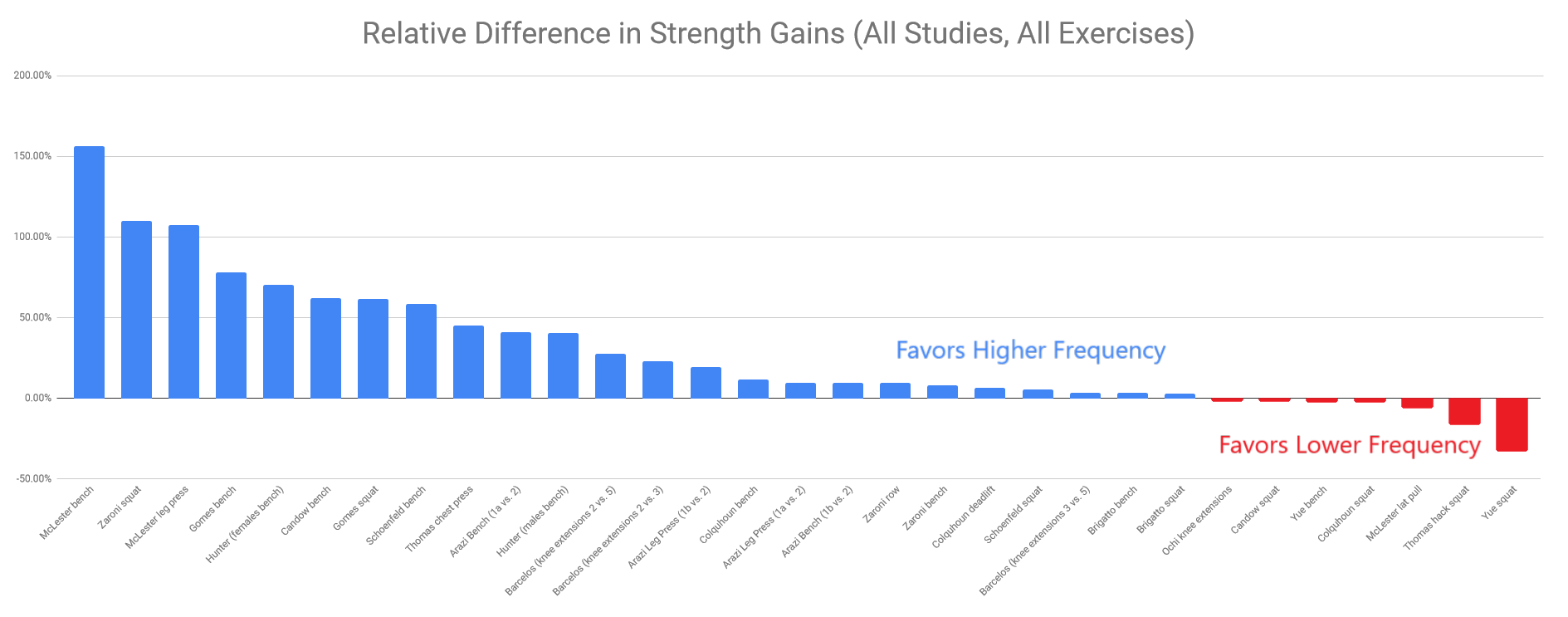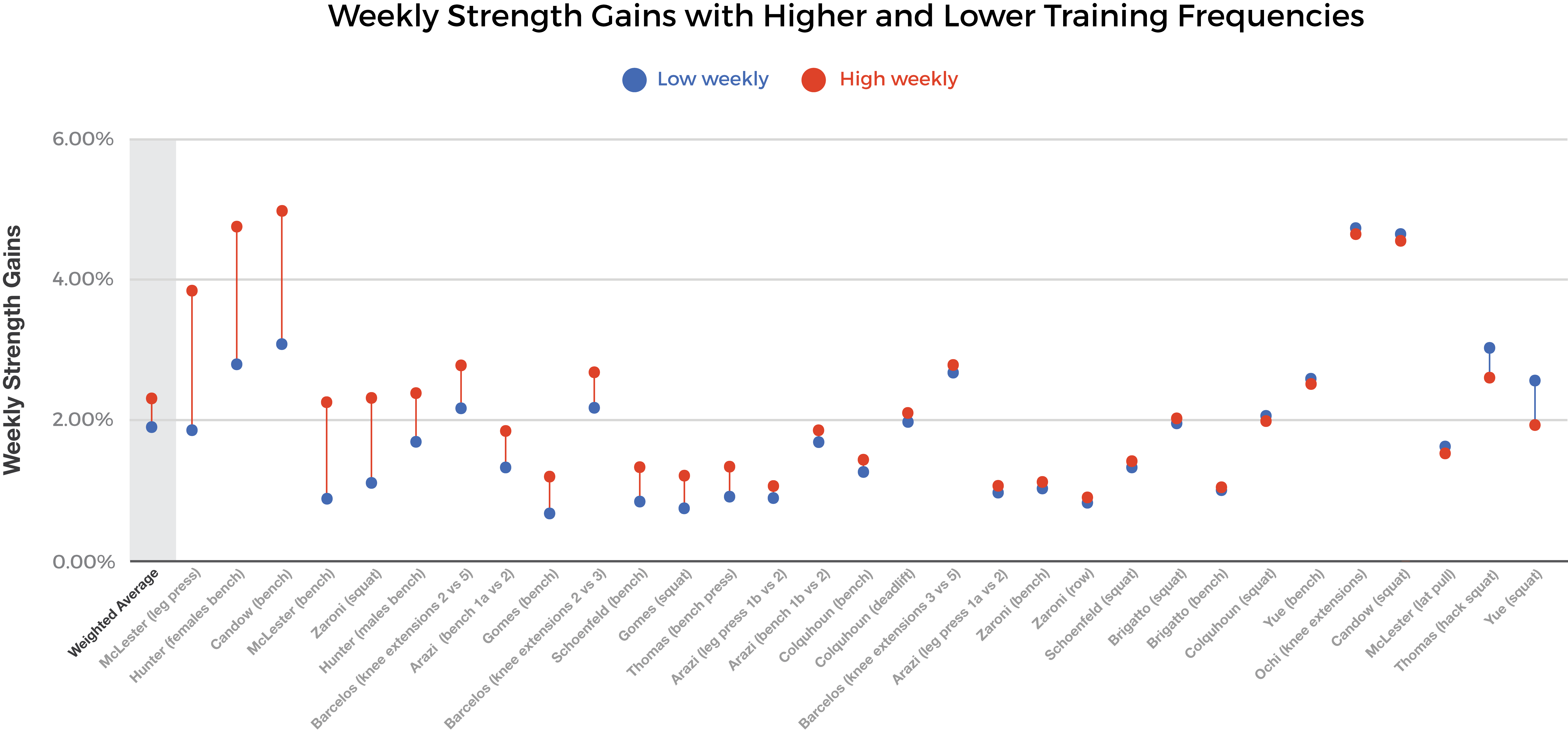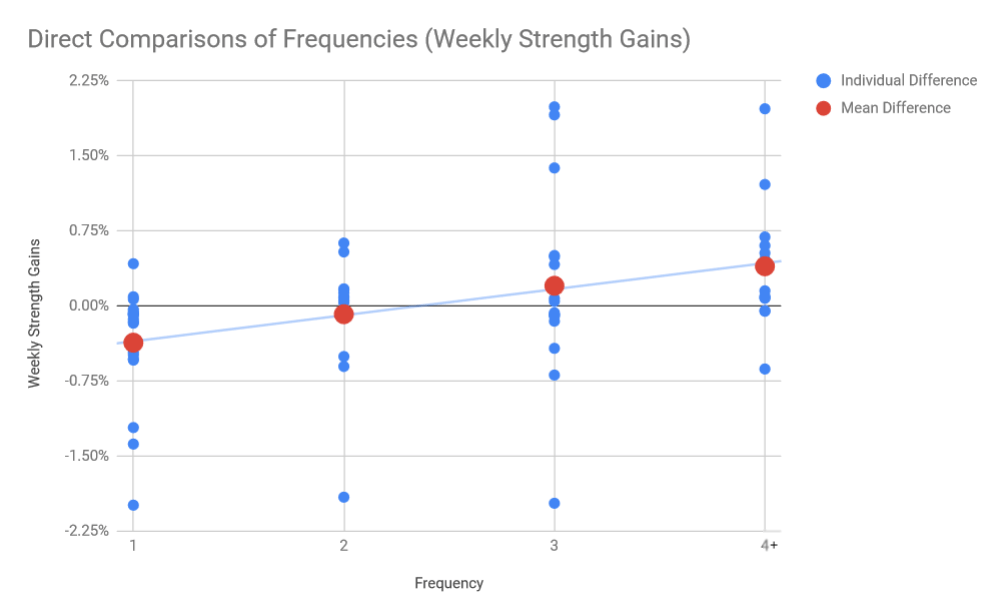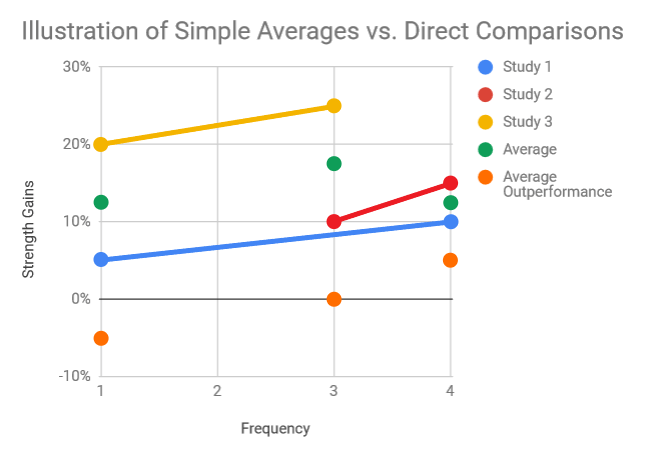I have a reputation as a “high frequency guy.” I’m not entirely sure that’s an accurate characterization of my actual training philosophies, but I can understand where it comes from. The first thing I did that garnered any significant attention was my experiment with Bulgarian-style training (maxing on squat and bench every day, and often multiple times per day), and one of the first popular articles on this site was a guest post by Martijn Koevoets about the famous (or potentially infamous) Norwegian Frequency Project. In reality, my own training frequency and my clients’ training frequencies have generally tended to be pretty typical, or maybe slightly on the high side of average (mainly for the bench press), but I’m far from a high frequency zealot. I just thought frequency was an interesting variable to manipulate once people started paying more attention to it. When I got into powerlifting, the general advice was that it was silly to ever exceed a frequency of twice per week for any lift, and squatting, benching, and deadlifting once per week was still very popular. So, when higher frequency systems started getting more popular, I thought they’d be fun to explore and write about.
One of the problems with discussing the effects of training frequency, however, was that there were a lot of anecdotes but very little research. In terms of volume-matched research, there was an old study from McLester and colleagues comparing once-per-week training to thrice-per week-training, and some work by Häkkinen and Hartman comparing once-daily training to twice-daily training, but the literature was pretty sparse. In 2012, the “Norwegian Frequency Project” came out and was greeted with a lot of fanfare due to the sparseness of the literature. It found that, in a group of pretty well-trained powerlifters, training each lift six times per week led to larger strength gains than training each lift three times per week when volume was equated (i.e. the thrice per week group did twice as many sets on each of their training days). For a long time, the debate about frequency centered on this study. One group of people contended that we should start increasing frequency since this study was the best evidence we had on the effects of high training frequencies in trained lifters, while another group argued that we should ignore it, since it was only presented as a conference abstract and was never actually published in a peer-reviewed journal.
Between 2012 and 2017, a couple more studies were published, but volume-matched frequency studies were still pretty scarce. A meta-regression on the relationship between frequency and strength gains by Grgic et al published in February 2018 (presumably submitted in late 2017) included just eight volume-matched studies, and one of them used peak torque as the strength measure (which doesn’t always agree with changes in dynamic strength), while another equated total volume load but not per-exercise volume. However, since then, the frequency literature has entered a renaissance. Eight more volume-matched studies have looked at the effects of frequency on strength gains, and seven of them have used 1RMs as their strength measure. So, just in the past few months, the pool of volume-matched frequency studies has doubled from 8 to 16, and the pool of frequency studies matching per-exercise volume and using 1RMs as their measure of strength has more than doubled from 6 to 13.
So, much like my recent articles on rep ranges and periodization, I want to move the conversation about training frequency beyond anecdote and beyond the fixation on a single study. Strap in. This is going to be a wild ride.
If you’re more interested in muscle growth than strength gains, I have an article about the effects of training frequency on muscle growth as well.
Technical Notes
Feel free to skip this section if you trust me to not fuck things up too badly.
I started by searching several databases to find all of the relevant studies, based on four criteria.
- The study needed to examine the effects of training frequency with volume and intensity per exercise or muscle group matched. The training intervention needed to last at least 6 weeks.
- The study needed to report changes in dynamic, isoinertial strength (i.e. 1RMs, not torque or isometric force measures).
- The subjects needed to be healthy and non-elderly (since age could conceivably affect the relationship between frequency and strength gains, as older people recover slower from training).
- The study needed to be published in a peer-reviewed journal.
From each study, I pulled all relevant info, including length of the training period, number of subjects, pre- and post-training strength, and pre-training standard deviations. In studies that only reported single-joint strength measures (two papers looked at knee extensions), I included single-joint strength measures. For studies that reported both single-joint and multi-joint strength measures, I only included multi-joint strength measures. From there, I calculated effect sizes ((post – pre)/(pooled pre-training SD)) and percentage strength gains ((post – pre)/pre) for each strength measure in each study. I also calculated percentage strength gains per week.
I analyzed these studies several different ways. I started with a mixed-effects meta-analysis of effect sizes (I found a way to do them in Excel. Thank you Neyeloff et al.!) with frequency as a binary term (i.e. higher frequency vs. lower frequency), including all exercises from all studies. I also calculated the pooled average percent strength gains, pooled weekly percent strength gains, and difference between groups for all exercises in all studies as a more easily interpretable meta-analysis, since effect sizes can sometimes seem somewhat abstract.
I made two tables for further analysis: one table of the weekly percentage strength gains for each frequency in all studies, and one table of the difference in weekly percentage strength gains for each frequency. In this second table, for example, a frequency of three per week was occasionally the high frequency condition, and occasionally the low frequency condition; this allows for comparisons between a given frequency and all other frequencies (both higher and lower) to see if there’s a frequency “sweet spot” or a range of frequencies that tends to perform best.
As a sub-analysis, I analyzed studies comparing frequencies of once or twice per week to frequencies of 3+ times per week, and studies comparing frequencies of 1-3x per week to 4+ times per week using weekly percent strength gains. As further sub-analyses, I analyzed frequency as a binary term using percentage weekly strength gains in studies on trained lifters, studies on untrained lifters, measures of pressing strength, and measures of quad-dominant compound lower body strength.
Results
Thirteen studies with a total of 328 subjects met the inclusion criteria, allowing for 31 comparisons. The average study was 8 weeks long (range: 6-12), with 10.9 subjects per training group (range: 9-20). Five studies used untrained subjects, and eight used subjects with at least some prior training experience.
The random effects meta-analysis found that higher training frequencies were associated with larger strength gains, though the overall effect was small (d=0.265; CI=0.08-0.45). This was a significant difference (p=0.0088). Upon visual inspection, there were two exceptionally large between-group effect sizes. I tested whether they were unduly affecting the results. After removing them, the effect size decreased nominally but would still be classified as a small effect (d=0.248; CI=0.14-0.36), and the p-value actually decreased as well, since the confidence interval shrunk (p=0.0001).
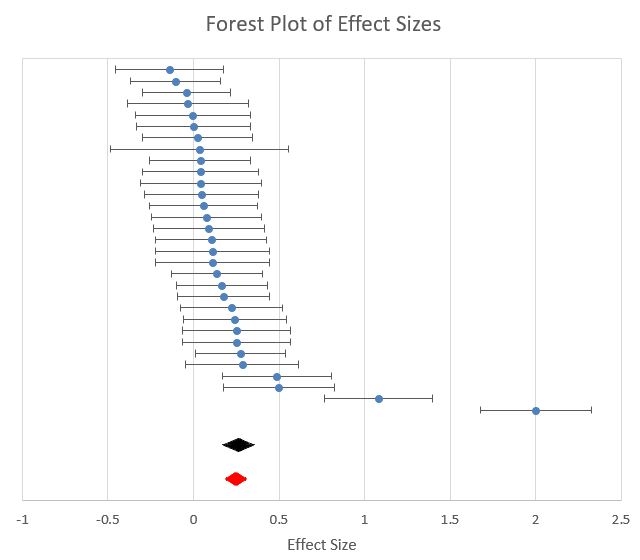
On average, subjects in the lower frequency groups got 14.65% stronger (CI=11.47-17.83%), while subjects in the higher frequency groups got 18.04% stronger (CI=14.34-21.73%). The average difference in strength gains between groups was 3.39% (CI=1.39-5.39%), meaning the higher frequency groups gained about 23% more strength than the lower frequency groups, on average (i.e. 18.04% is 23% greater than 14.65%). This would be classified as a small effect (d=0.35; CI=0.14-0.55), and the difference was significant (p=0.0024).
On average, subjects in the lower frequency groups got 1.91% stronger per week (CI=1.53-2.29%), while subjects in the higher frequency groups got 2.32% stronger per week (CI=1.89-2.75%). The average difference in weekly strength gains between groups was 0.41% (CI=0.18-0.64%), meaning the higher frequency groups gained strength about 21% faster than the lower frequency groups, on average. This would be classified as a small effect (d=0.36; CI=0.16-0.56), and the difference was significant (p=0.0018).
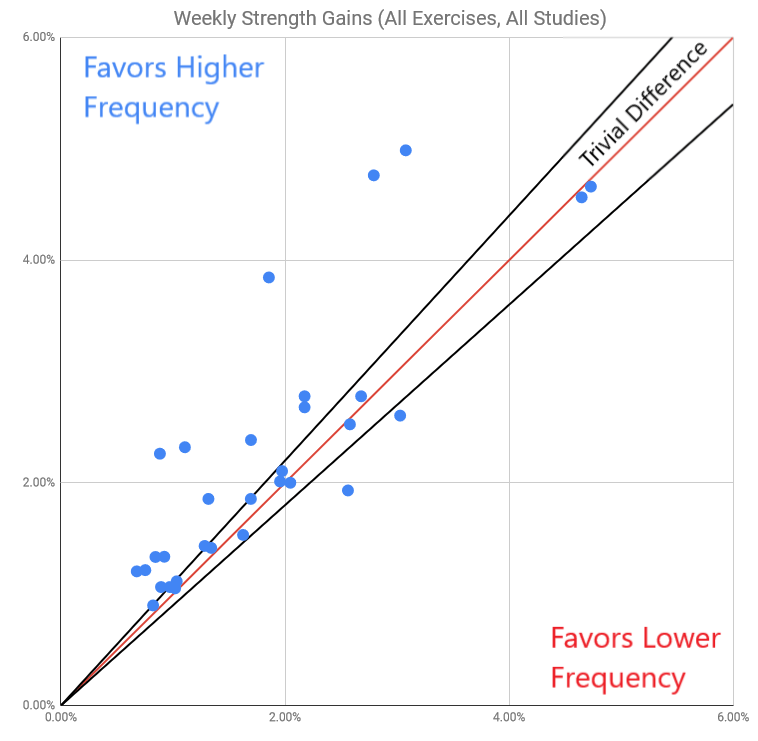
On average, untrained subjects in the lower frequency groups (12 exercises across 5 studies) got 2.50% stronger per week (CI=1.79-3.20%), while untrained subjects in the higher frequency groups got 3.07% stronger per week (CI=2.27-3.87%). The average difference in weekly strength gains between groups was 0.57% (CI=0.17-0.98%), meaning the higher frequency groups gained strength about 23% faster than the lower frequency groups, on average. This would be classified as a small effect (d=0.43; CI=0.13-0.73), and the difference was significant (p=0.02).
On average, trained subjects in the lower frequency groups (19 exercises across 8 studies) got 1.49% stronger per week (CI=1.18-1.80%), while trained subjects in the higher frequency groups got 1.78% stronger per week (CI=1.47-2.09%). The average difference in weekly strength gains between groups was 0.29% (CI=0.02-0.56%), meaning the higher frequency groups gained strength about 20% faster than the lower frequency groups, on average. This would be classified as a small effect (d=0.42; CI=0.03-0.81), and the difference was significant (p=0.046).
When simply looking at the mean weekly strength gains with each frequency, it appears that a frequency of 3x per week is best. Average weekly strength gains were 1.47% with a once-per-week frequency, 2.17% with a twice-per-week frequency, 2.61% with a thrice-per-week frequency, and 2.10% with a frequency of 4+ times per week. The only significant difference was between a frequency of once per week (CI=1.05-1.89% per week) and thrice per week (CI=1.99-3.23% per week), but the overall trend seems to suggest that a thrice-per-week frequency is best.
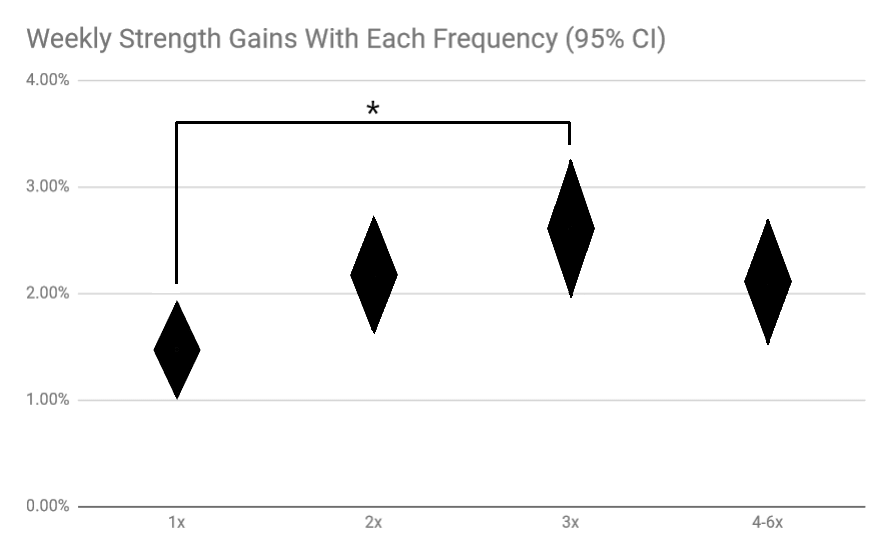
However, direct comparisons tell a different story. When a frequency of once per week (N=20 comparisons from 9 studies) was directly compared to other frequencies, it underperformed in direct comparisons by 0.366% per week. A frequency of twice per week (N=13 comparisons from 6 studies) underperformed very slightly in direct comparisons, by 0.082% per week. A frequency of three times per week (N=16 comparisons from 8 studies) overperformed in direct comparisons by 0.202% per week. Frequencies of four (N=4 from 2 studies) and five (N=7 from 3 studies) times per week overperformed in direct comparisons by 0.495% and 0.439% per week, respectively. A frequency of six times per week only slightly overperformed in direct comparisons (0.053% per week), but there were only two comparisons from one study to draw on. This analysis makes it look like a frequency of 4-5 times per week is best. However, a drawback is that few studies looked at frequencies exceeding three times per week. To account for this fact, we can pool the results of studies using frequencies of 4+ times per week (N=13 comparisons from 6 studies), finding that frequencies of 4+ times per week overperformed in direct comparisons by 0.397% per week. Higher frequencies were associated with larger strength gains (r=0.39).
You may be wondering why the results of the last two analyses differ. Here’s a simple illustration. Imagine you have three studies. One compares a frequency of once per week to a frequency of four times per week, the second compares a frequency of three times per week to a frequency of four times per week, and the third compares a frequency of once per week to a frequency of three times per week. In the first study, the low frequency group (1x) gets 5% stronger and the high frequency group (4x) gets 10% stronger. In the second study, the low frequency group (3x) gets 10% stronger and the high frequency group (4x) gets 15% stronger. In the third study, the low frequency group (1x) gets 20% stronger, while the high frequency group (3x) gets 25% stronger. Just averaging the strength gains, you see a 12.5% increase with once per week [(5%+20%)/2], a 17.5% increase with three times per week[(10%+25%)/2], and a 12.5% increase [(10%+15%)/2] with four times per week. It looks like 1x per week and 4x per week lead to similar gains, while 3x per week leads to the largest gains; however, those conclusions are driven by differences between studies, not differences between frequencies. With direct comparisons, on the other hand, 1x underperforms both 3x and 4x by 5%, 3x overperforms 1x by 5% and underperforms 4x by 5% (average 0%), and 4x overperforms both 1x and 3x by 5%. This more accurately represents the results in this imaginary trio of studies, because it does a better job accounting for the variability of results between studies.
With this in mind, I looked at studies comparing frequencies of 1-2x per week versus 3+ times per week (N=20 comparisons from 10 studies), since frequencies of once and twice per week underperformed in direct comparisons, while frequencies of 3+ times per week overperformed. Frequencies of once or twice per week led to strength gains of 1.94% per week, on average (CI=1.41-2.47%), while frequencies of 3+ times per week led to strength gains of 2.37% per week, on average (CI=1.82-2.92%). The average difference in weekly strength gains between groups was 0.43% (CI=0.12-0.74%), meaning the higher frequency groups gained strength about 22% faster than the lower frequency groups, on average. This would be classified as a medium effect (d=0.60; CI=0.16-1.04), and the difference was significant (p=0.014).
Finally, I wanted to see if the effects of frequency depended on the type of movement being trained. There were 11 comparisons in 10 studies for quad-dominant, compound lower body exercises (squat, leg press, and hack squat), and 13 comparisons in 11 studies for upper body pressing exercises (bench press or machine chest press).
For lower body exercises, frequencies of once or twice per week led to strength gains of 1.92% per week, on average (CI=1.24-2.61%), while frequencies of 3+ times per week led to strength gains of 2.19% per week, on average (CI=1.52-2.85%). The average difference in weekly strength gains between groups was 0.26% (CI=-0.18-0.70%), meaning the higher frequency groups gained strength about 14% faster than the lower frequency groups, on average. This would be classified as a small effect (d=0.35; CI=-0.24-0.94). This was not a significant difference (p=0.27).
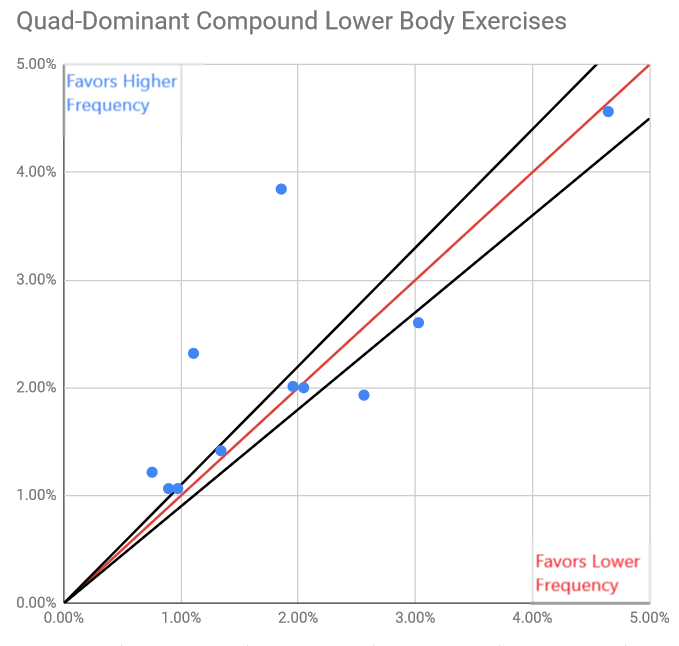
For upper body exercises, frequencies of once or twice per week led to strength gains of 1.52% per week, on average (CI=1.09-1.96%), while frequencies of 3+ times per week led to strength gains of 2.16% per week, on average (CI=1.46-2.87%). The average difference in weekly strength gains between groups was 0.64% (CI=0.27-1.01%), meaning the higher frequency groups gained strength about 42% faster than the lower frequency groups, on average. This would be classified as a large effect (d=0.93; CI=0.39-1.47), and the difference was significant (p=0.0056).
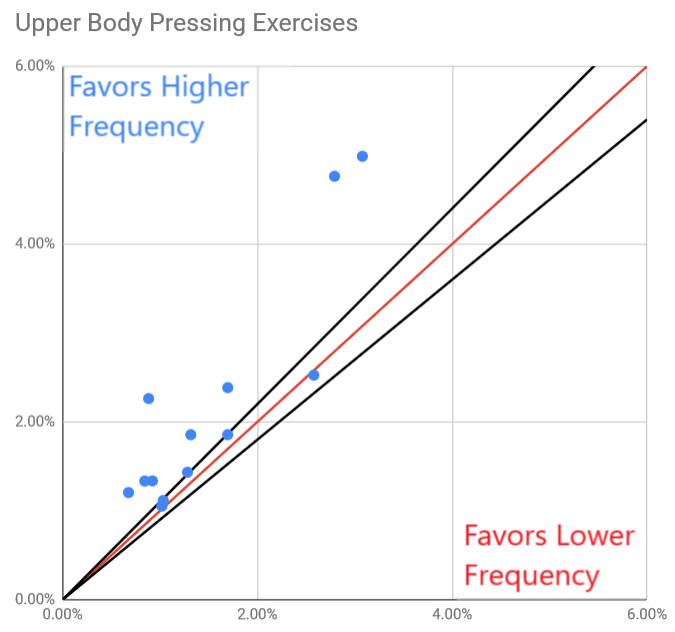
Getting even more granular, we can analyze the frequency/strength gains slopes in each study to estimate the additional strength gains you could expect by increasing your frequency by one additional day per week. For example, if group 1 trains with a frequency of once per week and increases strength by 10%, while group 2 trains with a frequency of thrice per week and increases strength by 20%, the slope would be (20%-10%)/(3-1)=5% per additional training day. Since we see a roughly linear relationship between weekly strength gains and frequency from 1 to 4+ times per week, I feel pretty confident that this sort of analysis would hold up to frequencies of at least 4 or possibly 5 times per week, but I wouldn’t feel confident extrapolating it to six or seven days per week. Since we see clear differences between pressing exercises and compound, quad-dominant lower body exercises, I’ll just focus on them here.
For upper body exercises, each additional day of frequency increased weekly strength gains by 0.51% (CI=0.14-0.88%). The average upper body weekly strength gains across all frequencies in all studies was 1.84%, meaning each additional day of training frequency increased rate of strength gains by 28%, on average (CI=8-48%). This slope was significantly different from zero (p=0.019).
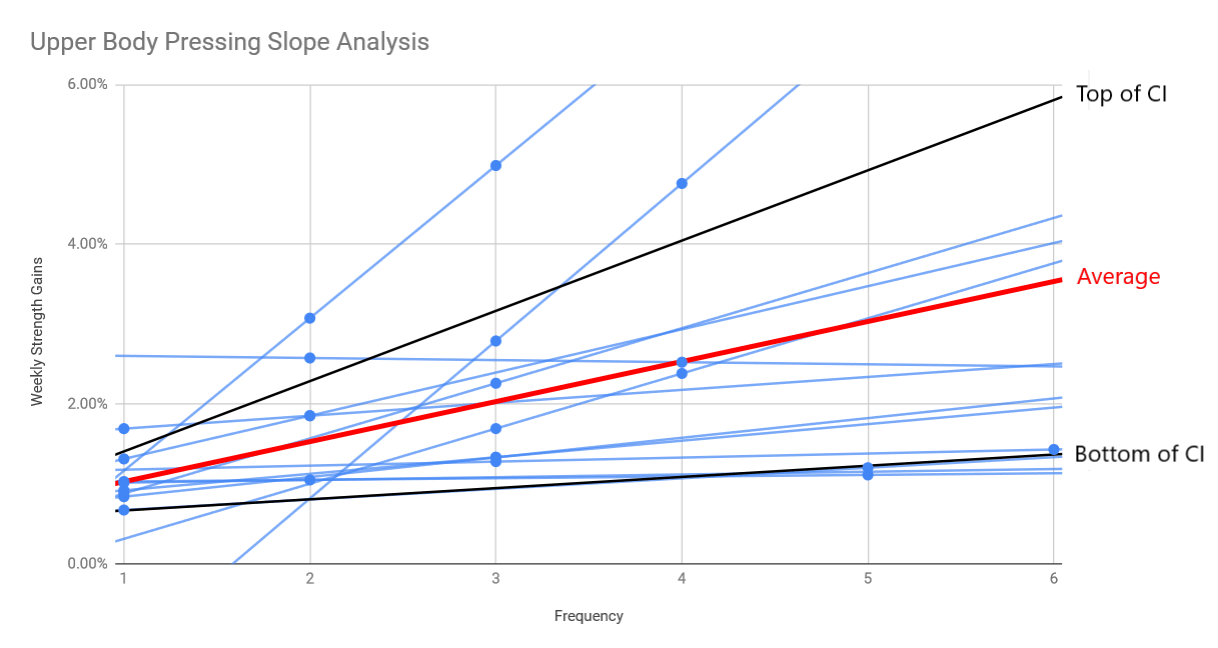
For lower body exercises, each additional day of frequency increased weekly strength gains by 0.10% (CI=-0.10-0.31%). The average lower body weekly strength gains across all frequencies in all studies was 2.05%, meaning each additional day of training frequency increased rate of strength gains by 5%, on average (CI=-5-15%). This slope was not significantly different from zero (p=0.33).
Discussion
Even when volume is matched, it seems that higher training frequencies lead to larger strength gains. Especially for upper body pressing exercises, spreading a given number of sets over more training days (up to at least 4) seems to increase strength gains.
Across most analyses, higher frequencies seem to lead to 20-23% faster strength gains, in both trained and untrained lifters, and there seems to be a fairly linear increase in the benefits of increased frequency, with 1<2<3<4+. However, we don’t have enough studies with frequencies exceeding 4x per week to provide much granularity past that point. Of note, it doesn’t seem that frequency significantly affects lower body strength gains, while it does significantly affect upper body strength gains. Overall, I’m quite confident in these results, as the confidence intervals typically aren’t particularly close to zero, and the p-values for most comparisons are quite low (0.046 for trained lifters, but ≤0.02 for all other other comparisons).
This may surprise some readers, because many of the individual studies didn’t find significant differences between frequencies. However, I think the protein literature provides us with an apt comparison here. The majority of studies comparing different protein intakes don’t find significant differences in muscle or strength gains, but meta-analyses consistently show that eating more protein (up to ~1.6-2.2g/kg, or ~0.73-1g/lb) tends to be better. Most of the individual studies in both bodies of literature fail to find significant differences due to low statistical power, but the hefty majority of the results lean in one direction, making the difference clear when results are pooled. Of the 31 comparisons, the higher frequency group made >10% larger gains than the low frequency group 15 times, both groups made roughly similar gains (within 10% of each other) 14 times, and the low frequency group only made >10% larger gains than the high frequency group twice. For upper body pressing, the consistency is even greater. Of the 13 comparisons, the higher frequency group made >10% larger gains than the low frequency group 9 times, both groups made roughly similar gains 4 times, and the low frequency group never made gains >10% larger than the high frequency group.
With any analysis, however, it’s important to make sure the results aren’t influenced by outlier results. For upper body pressing specifically, there were three relative differences that were quite large: female bench press in Hunter, bench press in McLester et al., and bench press in Candow and Burke. In all three of these studies, the higher frequency group outpaced the lower frequency group by more than 1% per week. However, when removing the results from these three studies, the effect size actually increases from 0.93 to 1.18, and the p-value decreases slightly. The results of the other studies were so consistently in favor of higher frequencies for pressing, that three unusually positive results depressed the effect size by increasing the standard deviation! So, that finding (which I consider the most important overall) seems quite robust. For all other analyses, the overall effect was very consistent (20-23% larger strength gains with higher frequency), even when using different frequency thresholds and when examining both trained and untrained lifters independently, which makes me feel pretty confident that we’re seeing a true and reliable effect.
The biggest drawback of this analysis was that defining frequency was somewhat subjective. Some studies used the same exercises in every training session, which made defining frequency straightforward. However, other studies used per-muscle group frequency rather than per-exercise frequency, so in a study with bench press as a primary strength outcome, one group may have done bench press on day 1, incline on day 2, and machine chest press on day 3, while another group did all three of those exercises on the same day. Bench press frequency was just once per week in both groups, but there was a difference in how frequently the pressing muscles were trained. In situations like this, I counted it as a frequency difference of 3x per week versus once per week. I made this decision based on this paper looking at the effects of exercise variation (it found that performing a main lift, plus biomechanically similar exercises, may lead to larger strength gains than just performing the main lift for more volume), but note that the results may not be perfectly reflective of “real-world” training, since most people would increase frequency of the bench press, specifically, when they increase pressing frequency.
Another drawback, similar to the periodization review, is that the “trained” lifters still weren’t super well-trained, so we can’t know how well these results would generalize to people who aren’t beginner or intermediate-level lifters.
On the topic of applying these results to real-world training, I think that, if anything, this analysis may underestimate the effects of training frequency. In all of these studies, volume was controlled. However, in the real world, increased training frequency is often used as a tool to increase volume. For example, 10 hard sets of squats in a workout is going to make for a brutal workout, and that may be all of the squatting volume you can handle if you just train the squat once per week. However, four hard sets of squats, three times per week is probably going to be very doable, even though weekly volume is higher. Five hard sets, three times per week may be just as challenging as 10 sets in a single session, but it represents a 50% increase in weekly training volume. So, it seems that higher frequency independently promotes larger strength gains, and it seems likely that the benefits of higher frequencies and higher volumes would be additive. The recent Grgic meta-analysis supports this idea. In analyses where volume wasn’t controlled, higher frequencies were strongly associated with larger strength gains.
While we’re on the subject of training volume, I think it would be helpful to contextualize the overall effect of frequency. Boosting strength gains by ~20% with higher training frequencies may not sound like much (that would be the difference between adding 30 pounds to your total instead of 25), but it’s actually on par with the effect of volume. A recent meta-analysis by Ralston et al found that higher weekly set volumes (5+ sets per exercise, per week) led to ~20% larger strength gains than lower weekly set volumes (<5 sets per exercise, per week). Overall, neither volume nor frequency make a night-and-day difference for strength gains (intensity seems to be the biggest driver), but they both seem to have similar, positive effects.
One interesting finding was that frequency seems to affect upper body strength gains (specifically for pressing exercises), but not lower body strength gains. Initially, I thought this may be related to differences in training status, as in my periodization review. In that review, periodization seemed to affect upper body strength gains more than lower body strength gains, and lower body strength gains were substantially larger than upper body strength gains (potentially indicating the subjects had more prior experience with hard upper body training than hard lower body training). However, lower body strength gains were quite similar to upper body strength gains in this review (2.05% per week for lower body, and 1.84% per week for upper body), and the overall effect sizes were almost identical for trained and untrained lifters. So, I don’t think differences in training experience with upper versus lower body exercises are a likely explanation. It may instead be that upper body muscles recover faster between training sessions, facilitating higher training frequencies. Anecdotally, I find that to be the case.
Many frequency skeptics will posit that studies showing benefits of higher frequencies are really just picking up the effects of novelty. Especially for bodybuilders, low frequencies are still the norm, so maybe people just make larger strength gains when you put them on a program they’re unaccustomed to. However, the relative advantage of higher frequencies actually tended to either be the same or a bit larger in longer studies (the trend had a small positive slope, but the r value was just 0.23, and the correlation wasn’t significant). Since none of the studies in this review ran longer than 12 weeks, we don’t have evidence about truly long-term effects of different training frequencies, but this does at least suggest that the advantage isn’t driven by novelty. On the contrary, it may be that more evenly dispersing training stress across a week matters less for short-term training, with benefits accruing over longer periods of time as loads increase and fatigue builds.
So, the question becomes: why do higher frequencies lead to larger strength gains, even when controlling for volume and intensity?
The first potential explanation that may come to mind would be hypertrophy. However, the effects of frequency on hypertrophy are somewhat inconclusive. A 2016 meta-analysis by Schoenfeld et al found that training frequencies of at least twice per week led to more hypertrophy than frequencies of just once per week, but the current literature doesn’t let us know, with any degree of reasonable certainty, whether even higher frequencies are even better for hypertrophy. So, I feel pretty confident saying that less hypertrophy may partially explain the underperformance of once per week frequencies, but I wouldn’t feel confident saying that increased hypertrophy was able to explain the progressive outperformance of progressively higher frequencies (i.e. I wouldn’t feel confident saying that we should expect a hypertrophy difference when comparing 2x per week to 4x per week frequencies).
Another potential explanation is that higher frequencies still allow for higher total volumes, even if work set volume is still the same. With higher frequencies, you still have to warm-up for every session, and while warm-up sets are easy, it’s not like your last couple of warm-up sets impose literally zero training stress.
Another potential explanation is superior skill acquisition and motor learning. In general, you learn and master skills faster when you practice them more frequently. However, I’m not sure how well this explains the results in this particular set of studies because a) if you posit that motor learning explains the differences, you’d expect larger benefits in untrained lifters (who are further from mastering the motor skills being tested), and that’s not what we see, and b) if you’ll remember, in many of these studies, per-muscle frequencies differed, but per-exercise frequencies didn’t. Thus, more frequent practice may play a role (and intuitively, I feel like more frequent practice is an important factor), but I wouldn’t want to lean on it as the primary explanation.
Finally, I think increased frequencies likely improve average training quality. If you have to do three sets of squats in a session, all three sets will probably be pretty good sets. If you do that two more times in a week, you’ve accumulated nine high-quality sets. However, if you did all nine sets in a single training session, the quality of those sets would probably start decreasing well before you finished your ninth set. If you want to use a more concrete concept than “quality,” average bar speed will probably be higher with fewer sets per muscle group, per workout. If you move the same load at a faster speed, force output per rep is higher, thus increasing specificity and overall training stress.
If you put a gun to my head and forced me to say which of these factors matters the most, I’d speculate that higher average training quality is the most important, followed by skill acquisition, hypertrophy, and volume from warm-up sets (in that order).
Practical Recommendations for Training Frequency
At this point, I want to make sure everyone pauses for a moment of clarity before people go out into the world and claim that you should train bench three times per day to maximize strength gains. These studies all lasted 12 weeks or fewer; we tend to assume that things that provide larger gains in the short term will also provide larger gains in the long-term, but we can’t know that for sure. Also, this is science, and science mostly deals with averages. These findings may or may not apply to you as an individual. Plenty of people have gotten super strong with low training frequencies, after all. If your shoulder starts bothering you when you bench three or more times per week, don’t force yourself to grind through the pain because science(tm) says higher pressing frequencies are optimal(c). On the flip side, if you find that you respond really well to squatting four times per week, don’t dial back the frequency because this analysis found that frequency didn’t matter as much for squats on average.
With those two big caveats in mind, I think the major takeaway is that higher frequencies (up to at least 4-5x per week) seem to lead to larger strength gains for upper body pressing exercises, on average, in both trained and untrained lifters, even when volume and intensity are equated. On the other hand, strength gains for squat-type movements seem to be less affected by frequency. If anything, I think this analysis may understate the effects of frequency in the “real world,” because volume was equated in all of these studies, although higher frequencies naturally allow for higher volumes in a real-world scenario. I wouldn’t profess to know why, mechanistically, higher frequencies lead to larger strength gains (and why there’s a difference for upper body but not lower body), but I think average training quality and skill acquisition are probably the two biggest contributors, while the effects of hypertrophy play a smaller (or perhaps nonexistent) role once you get beyond a frequency of just once per week.
If you decide to increase your training frequency for a particular lift, I’d strongly recommend dialing back your per-session volume until you adjust (keeping your weekly volume unchanged). I’d also recommend making one of your additional sessions an “easy” session where you stick with lighter loads than you’d normally use, and stay at least 3-4 reps from failure. Once you see how well you’re recovering between sessions, you’ll know when you’re ready to start ramping up per-session volume.
If you’ve made it this far, you should consider signing up for Monthly Applications in Strength Sport. It’s a research review that Eric Helms, Mike Zourdos, and I publish every month, breaking down the recent research that’s most relevant and useful for strength and physique athletes and coaches. You can snag a free issue here if you’d like to check it out.
Edit/Correction
I realized I shouldn’t have included the Barcelos study (it wasn’t volume-matched). I also realized the couple of exceptional large between-group effect sizes were due to studies reporting standard errors instead of standard deviations. Those issues don’t affect the finding I consider to be most important (the large, positive effect on upper body pressing exercises). Furthermore, removing the Barcelos study and fixing the effect sizes affected by the SD/SEM issue didn’t materially affect the result from the random effects meta-analysis (d=0.265 before; d=0.211 now). The positive trend for increased strength gains with increased frequencies is still there (1x still underperforms by 0.366% per week, 2x now slightly overperforms by 0.004% per week, 3x still overperforms by 0.202% per week, and 4+ now overperforms by 0.405% per week). None of the results of any of the other analyses materially changed either (everything is still statistically significant, the percent differences are all basically the same, none of the effect sizes are materially different, etc.). When a few more frequency studies are published, I’ll give this article a full update and change all of the graphics to remove the Barcelos results and update the forest plot. For the time being, however, I’m just leaving it as-is, since it would take a ton of time to re-do all of the graphics, and ultimately, the overall picture and the takeaways are completely unaffected. I apologize for these oversights upon initial publication.



